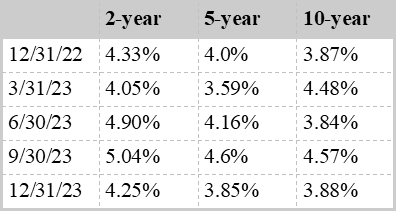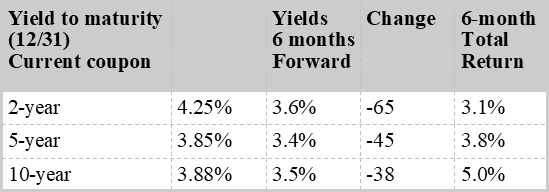Bond Market Update
The Federal Reserve’s fight against inflation appears to be finally paying dividends. From a high of over 9% in early 2022 the consumer price index (CPI) has come down into the low 3% range; in November core inflation (which excludes the volatile components of food and energy) was reported a 3.1%. While still above the Fed’s target of 2%, inflation has improved substantially. Bond yields reacted positively with yields declining to levels at or below year end 2022 levels. Yields had reached recent highs in October with the 10-year yield moving above 5%. Equity prices have gotten a boost as well from the expectation of lower interest rates.
Here is a recap of yield levels this year for US Treasury securities:

The Fed has two mandates— inflation and employment. The focus has been on bringing high inflation down. Now that prices are heading lower, the focus shifts to preventing a recession by keeping employment firm. The Fed last increased interest rates in July when the Fed Funds rate settled at the current level of 5.25 – 5.5%. At its most recent meeting in December, Fed chair Powell indicated it will pivot toward rate cuts, with as many as three quarter point reductions in 2024. This change in direction clearly indicates the final rate rise is behind us. However, the timing of the first reduction and the pace of the cuts is still dependent on future growth and inflation numbers.
There is no guarantee the economy will escape recession. Interest rates remain at levels not seen in over 20 years and the effects of high rates may still negatively impact interest rate sensitive sectors of the economy. We expect a modest economic slowdown. Inflation may decline further with continued easing in supply chain pressures. But lower rates and rising stock prices could fuel growth and potentially lead to higher prices, especially in housing and services.
The Fed’s next move is certain to be lowering interest rates. But with its dual mandate of inflation and employment we do not expect aggressive rate cuts until the economy and/or employment weakens. The move in interest rates may have gotten ahead of itself: the rapid decline in yields to current levels leaves limited room for further gains until the Fed begins to cut rates and there is more clarity on the magnitude and timing of rate reductions.
If rate cuts materialize, the yield curve will shift downward with short term rates declining rapidly as these cuts materialize. The inverted yield curve of today could be positively sloped by mid-year. Bonds will provide good total returns especially longer-term bonds. The table below displays potential returns as yield moves down and the curve normalizes even if it does not return to a positive slope.

As shown, as rates fall and the yield curve normalizes the greatest price appreciation will come from longer term bonds even with a much smaller yield decline.
The year 2023 ended with a powerful rally in equity markets and sharp a decline in bond yields. This move was in reaction to the Fed indicating a shift from tightening to easing interest rates. However, the Fed indicated three ¼% reductions in the Fed Funds rate while the markets have extrapolated a more aggressive easing campaign, with some forecasters calling for as many as six cuts. Investors need to protect against any uptick in inflation combined with continued firm economic growth which could end in disappointment. In that case a negative market reaction could follow.
Real Rates
When purchasing a fixed income security at a fixed rate of interest, that rate does not account for inflation. It is important to know what the real return an investor is getting when factoring in inflation. This is why real rates matter.
When you buy a fixed income security you receive what is known as the nominal rate of interest; the interest shown for notes and bonds. A treasury security purchased at 100 cents on the dollar (or at par value) with a coupon of 5% will pay a nominal interest rate of 5%. However, this rate does not account for any decrease in purchasing power from inflation.
Since Inflation erodes the value of a fixed income security, investors need to look at real rates. Real rates refer to the rate of return after accounting for inflation, representing the actual growth in purchasing power an investor can expect to achieve after adjusting for inflation. Essentially…
Real Rate = Nominal rate minus inflation rate
It is the nominal interest rate minus the rate of inflation during the same period. Real rates are crucial for understanding the true value or return of an investment, as it considers the impact of inflation on the purchasing power of money. High real rates imply a higher return above inflation, while negative real rates mean the return is lower than the rate of inflation resulting in a decrease in purchasing power. For example, if the yield on a security is 5% and inflation is 2% then you are earning a real return of 3% over and above inflation.
The recent fall in inflation means short term real interest rates have been rising. This is the result of the Fed having kept nominal short-term rates unchanged while inflation has fallen. If the Fed continues to keep nominal rates high and inflation keeps falling, then the further rise in real rates will constrain the economy as it represents a form of tightening of monetary policy. Therefore, the Fed must walk a fine line between keeping nominal rates high enough to prevent the economy from overheating while realizing that as inflation falls real rates will rise and could cause a recession unless it reduces nominal interest rates.
How can fixed income investors protect against inflation?
One way to protect against inflation when investing in bonds is to buy treasury Inflation-protected securities (TIPS). This is a specific type of government bond issued by the U.S. Treasury that is designed to protect investors against inflation. TIPS work as follows:
- The TIPS bond principal rises with changes in the Consumer Price Index (CPI) and does not go down even if CPI declines.
- The Coupon rate remains constant.
Therefore, the inflation adjustment comes from the increase in principal value with higher inflation and a higher coupon payment based on the higher principal value. This feature ensures that the purchasing power of the bond remains relatively stable over time, making TIPS a popular choice for investors seeking protection against inflation.
In essence, while real rates focus on the actual return adjusted for inflation, TIPS are a financial instrument specifically structured to counter the effects of inflation by adjusting their value based on changes in the CPI. TIPS can provide a more direct hedge against inflation compared to other investment options, but their returns are still influenced by the level and direction of interest rates.
As always, if you have any questions about the bond market, you can reach us at (833) 888-0534 x2 or by email.
The views and information contained in this article and on this website are those of West Branch Capital LLC and are provided for general information. The information herein should not serve as the sole determining factor for making legal, tax, or investment decisions. All information is obtained from sources believed to be reliable, but West Branch Capital LLC does not guarantee its reliability. West Branch Capital LLC is not an attorney, accountant or actuary and does not provide legal, tax, accounting or actuarial advice.
About The Author
James K. Ho
Jim has over thirty years of investment management experience. He is a Managing Director and Principal of the firm. Prior to West Branch Capital, Jim was a fixed income Portfolio Manager at John Hancock Advisors. Previously, he managed the John Hancock Tax Exempt Income Trust. Prior to joining John Hancock Advisors, Jim was a Senior Investment Officer at The New England (MetLife), where he managed multiple bond portfolios, including taxable and tax exempt mutual funds and separate accounts. Jim holds an M.B.A. from Columbia University, New York, as well as an M.S. in Applied Math and B.S. in Applied Math and Economics from the State University of New York at Stony Brook. He is a Chartered Financial Analyst and a member of the Boston Society of Security Analysts.
Recent Articles

Categories




